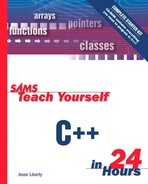Summary
In this hour you saw how to bring together many of the elements of C++ syntax and apply them to object-oriented analysis, design, and programming. The development cycle is not a linear progression from clean analysis through design and culminating in programming; rather, it is, in fact, cyclical. The first phase is typically analysis of the problem, with the results of that analysis forming the basis for the preliminary design.
After a preliminary design is complete, programming can begin; but the lessons learned during the programming phase are fed back into the analysis and design. As programming progresses, testing and then debugging begin. The cycle continues, never really ending, although discrete points are reached. There comes a time, however, when it is appropriate to ship the product. Don't hesitate, ship it!
When analyzing a large problem from an object-oriented viewpoint, the interacting parts of the problem are often the objects of the preliminary design. The designer keeps an eye out for process, hoping to encapsulate discrete activities into objects whenever possible.
A class hierarchy must be designed, and fundamental relationships among the interacting parts must be established. The preliminary design is not meant to be final, and functionality will migrate among objects as the design solidifies.
It is a principal goal of object-oriented analysis to hide as much of the data and implementation as possible and to build discrete objects that have a narrow and well-defined interface. The clients of your object should not need to understand the implementation details of how they fulfill their responsibilities.
